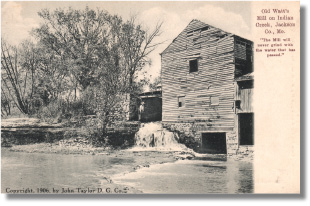
You might visit the area around 103rd Street and State Line Road if you were interested in purchasing an automobile these days, but 150 years ago it was the lively village of Dallas, Mo., home to Watts Mill on Indian Creek.
This week’s postcard, published in 1906 by the John Taylor Dry Goods Company of Kansas City, shows the old Watts Mill on the banks of Indian Creek in Jackson County, Mo. The mill was built of hand-hewn native oak and walnut in 1832 by Jackson County Judge John Fitzhugh, who operated it as a saw mill.
In 1849, Anthony Watts of St. Charles, Mo., purchased the mill and began its transition to a grist mill. During that time, the mill played a major role in the westward expansion. Many wagon trains stopped there to camp and have their corn and wheat ground prior to embarking on the Oregon and Santa Fe Trails.
Following the U.S. Civil War, Watts’ son Stubbins Watts took over the operation of the mill and operated it for more than 60 years.
Settlers and Native American Indians alike took their grain to Watts’ for grinding. The payment was usually one fifth of the ground grain. In 1942, Edgar Watts, Stubbins’ son, arranged for the eventual scrapping of the abandoned mill to aid the war effort. The mill was razed in 1949 and the land stood vacant for decades.
Today, a marker erected in the late 1970s by the Native Sons of Kansas City shows where the mill once stood and is set next to one of the original mill stones. Parts of the original limestone foundation of the mill can be seen along the banks of Indian Creek, too. Virtually no evidence of the hamlet of Dallas, Mo., exists today. A strip shopping center and garish-looking car lots mark the area where pioneers once camped en route to parts unknown along the westward trails.



















